Ducted whole house fans use a duct to pull air from inside a house and exhaust it to the attic. Unlike traditional whole house fans, which are mounted on the attic floor, ducted fans are suspended in the attic from the rafters. A mechanical vent fan is connected to the exhaust end of the duct to pull air. The intake of the duct is connected to a vent that opens into the house.
Given below is a picture of an ducted whole house fan;
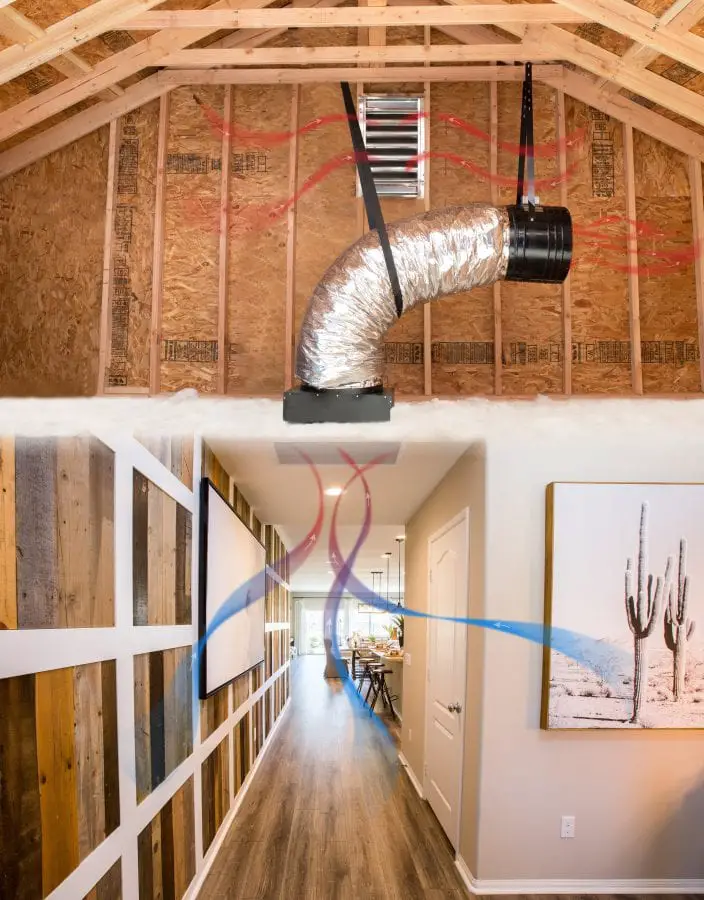
Ducted whole house fans are much quieter than traditional whole house fans since the fan is installed away from the living areas of the house. There are only a limited number of such fans available.
Here are the best ducted whole house fans for your home;
1. QuietCool CL-1500
QuietCool is the leading brand when it comes to ducted whole house fans. They have different models of ducted whole house fans with varying CFM. Given below is the least powerful one of them;
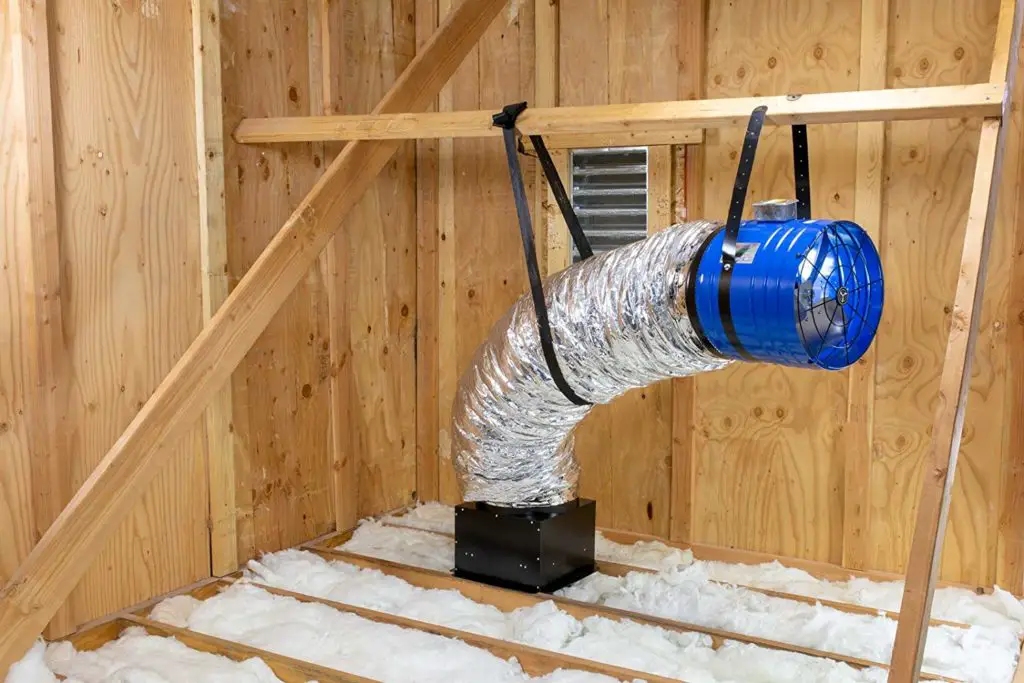
Highlights:
- Whisper-quiet operation with operating noise of only 37.4 decibels.
- 1472 CFM to cover 736 square feet of indoor area
- 10-years of warranty
- 2 speeds with thermostat control
This QuietCool fan runs at two speeds. At its highest speed, it delivers an airflow of 1472 CFM. It can cover 491 to 736 square feet of indoor area. The fan is connected to a duct of length 6 feet and diameter 14 inches. This duct is connected to a 16″ x 16″ intake vent installed through the attic floor.
This ducted whole house fan doesn’t come with any control options. But you can optionally buy a remote control to turn the fan on and off. (Refer: how to turn off an attic fan).
This is the quietest whole house fan on this list. It makes only 37.4 decibels of sound, which is as quiet as a whisper. In addition, this fan is covered under a 10-year limited warranty.
Other QuietCool ducted whole house fan models;
- CL-3100 : 3126 CFM
- CL-4700 : 4415 CFM
- CL-5400 : 5024 CFM
- CL-6000 : 5655 CFM
- CL-7000 : 6924 CFM
You can find all of them here.
Pros:
- The quietest whole house fan
Cons:
- No remote control comes with the fan, even though you can buy one separately.
2. Air+Health Everest
The Everest model by Air+Health is the second ducted whole house fan on this list. Here is its quick review;
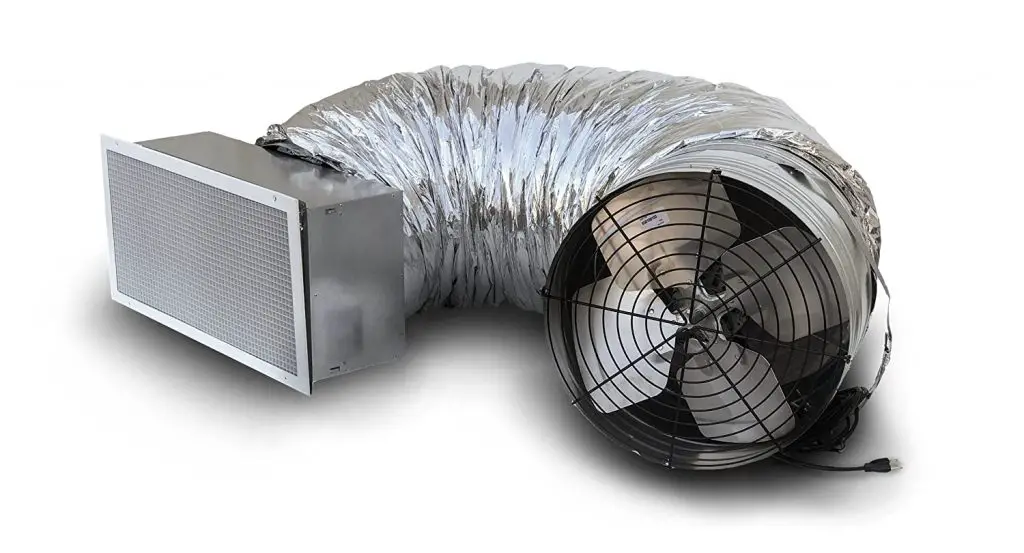
Highlights:
- ECM motor for better energy savings.
- Wall switch and timer control
- 2740 CFM airflow; the fan can ventilate up to 1500 square feet of indoor area.
- 12-year limited warranty
This is a slightly larger fan than the QuietCool one listed above. It produces an airflow of 2740 CFM, which is enough to cover floor areas up to 1500 square feet. The fan can be run at 3 speeds with an optional remote control. It has automatic temperature controls to change the fan speed based on preset temperatures.
This ducted fan uses an ECM motor which is quiet as well as energy-efficient. Its operating noise is below 53 decibels; that is quieter than a normal conversation between two people. Its duct is 7 feet in length and 18 inches in diameter to accommodate the high airflow of the fan. This duct is connected to an intake vent of size 16 x 24 inches.
This fan is covered under a 12-year limited warranty. It also comes in 4522 CFM, 5224 CFM and 6056 CFM sizes.
Pros:
- Whisper-quiet operation
- 12-year long limited warranty
- Energy-saving ECM motor
- A 2-speed wall switch comes with the fan
Cons:
- Remote control kit is not available with the fan unless bought separately.
3. AC Infinity CLOUDRAY T10
The 3rd ducted whouse house fan on my list is from the brand AC Infinity. Here is a quick review of this fan;
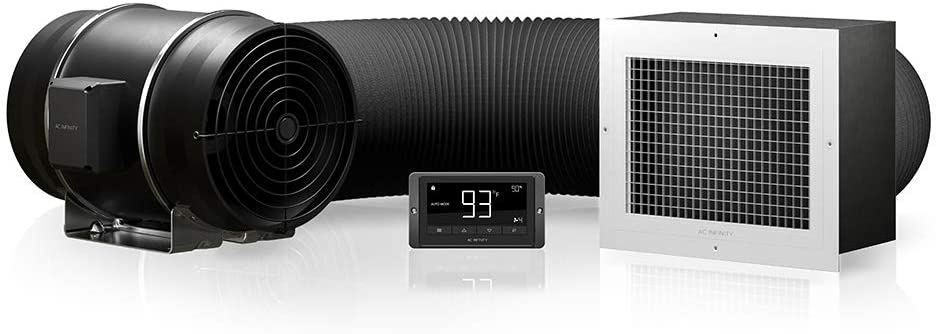
Highlights:
- Nice aesthetics
- Remote wireless control
- 1200 CFM suitable for up to 600 sq.ft
- 2-year warranty
This is a nice-looking whole house fan with a 5-foot long duct. The duct is 10 inches in diameter. The fan uses an EC motor which is more energy-efficient when compared to those with AC motors.
One thing that makes this fan stand apart from the others on this list is the remote control. Its remote control has multiple functionalities, including timers, temperature and humidity programming, fan speed control, and more. Based on the programming on the remote, the fan varies its speed to control the humidity and temperature of the air in the house.
The EC Motor and the duct also helps to run the fan whisper quiet. Its decibel rating is only 48 at its highest speed.
This is a comparatively smaller fan than the rest. However, it can move 1200 CFM of air which is good enough to ventilate areas up to 600 square feet. And the warranty of the fan is disappointing since they offer only a 2-year warranty which is the shortest on this list.
Pros:
- This is the most good-looking fan on this list.
- The multi-functional remote control it comes with is awesome
- Quiet and energy-efficient motor
Cons:
- Warranty coverage is only for 2-years which is the shortest on this list.
4. Centric Air 4.0
Centric Air is another popular brand selling ducted whole house fans. Here is my quick review of their model;
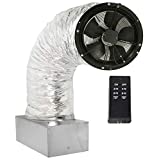
Highlights:
- Multi-functional control
- 15-year limited warranty
- 3945 CFM suitable for large houses
Centric Air 4.0 is a quiet whole house fan with an 8 feet duct connecting the fan and the intake vent. The duct is 14 inches in diameter, while the intake vent it connects to measures 16″ x 30″.
This fan can ventilate an area of up to 1950 square feet. It is also recommended for installation in 2-story houses due to its high air flow rate of 3921 CFM. The fan comes with a wall switch control that has speed control as well as temperature control options. The fan has two speeds, and it performs quietly. Its decibel level is 49 dBA which means that the fan runs whisper quiet.
This fan is covered under a 15-year limited warranty. It is also available in many other sizes; you can see the full list of its variations here.
Pros:
- A high airflow rate at 3945 CFM makes it suitable for large houses.
- Whisper-quiet operation
- The fan comes with a multi-functional wall control
- 15-year limited warranty
Cons:
Pricier when comepared to the other fans listed here.
Working
A ducted whole house fan works just like a traditional whole house fan. Its function is to replace the hot air inside a house with the cool air from outside.
The fan pulls air from the house through a vent installed on the attic floor of the house. The air pulled is vented into the attic and is vented out through the attic’s ventilation system. The suction of air creates a negative pressure inside the house, pulling the fresh air from the outside.
Since a whole house fan is installed at the center of the house, it can pull air from all directions. This makes it possible to ventilate the whole house within a short time.
Here is video detailing teh working of a ducted whole house fan;
Installation
A ducted whole house fan has three main parts;
- An intake vent which is installed on the ceiling of the house
- A duct
- A fan
Its installation is as easy as installing a traditional type one. Here is how it is done;
- Find the location: Find a suitable location for the installation. A whole house fan should be installed somewhat to the center of the house. This makes it possible to pull air from all parts of the house equally. The ceiling of the hallway is the ideal location in most houses.
- Cutting the hole: A hole matching the size of the intake vent should be cut on the attic floor. For most fans, this can be done without cutting the joists as they are sized to fit inside.
- Install the vent: The next step is installing the intake vent and its cover. Make sure to seal the ceiling to prevent any air leakages.
- Installation of duct and fan: Connect one end of the duct to the opening of the intake vent and the other to the fan. Then hang the fan and the duct from a rafter. The fan should be installed pointing to the exhaust ports of the attic to allow the air to move out easily.
Here is a video detailing the installation of a QuietCool ducted whole house fan;
Pros and Cons of ducted whole house fans
Pros:
The main benefit of using a ducted whole house fan is quietness. Traditional whole house fans are installed on the ceiling between the attic and the house’s living areas. This means the fan works close to where people are. So any noise from the fan can be heard inside. This gets really annoying if it is a large fan.
Since ducted whole house fans are installed inside the attic and away from the house’s living areas, it is hard to hear its sound. In addition, since the fan is suspended from the rafters instead of tightly held by the ceiling, the noise by the vibrations from it is zero. Also, any noise from the fan is muffled by the ceiling and the insulation on the attic floor. This makes the operation of duct-type whole-house fans whisper quiet.
Cons:
Ducted fans generally cost more than traditional type fans. This is due to the additional ducting and the extra accessories needed for its installation. The ducting of these fans are thermally insulated to prevent heat from going into the house. These thermal insulations is part of the reason why this type of fans are costly.
Another problem with ducted whole house fans is winterization. Even though the duct is insulated, the fan is not. This can cause heat loss.
CFM size requirements
For the same floor area, the size required for a ducted whole house fan and a traditional fan are the same. Here is a table listing the size requirement for different floor sizes;
| Floor Area | Fan Size |
|---|---|
| 700 Square feet | 1400 to 2100 CFM |
| 1200 Square feet | 2400 to 3600 CFM |
| 1800 Square feet | 3600 to 5400 CFM |
| 2200 Square feet | 4400 to 6600 CFM |
| 2500 Square feet | 5000 to 7500 CFM |
Related Posts:
- Ducted Whole House Fan Reviews: 4 Best Picks
- 3 Best 30 inch Whole House Fans for Cooling Large Spaces
- How To Make A Whole House Fan Quieter: 5 DIY Tips
- 4 Quiet whole house fans with whisper-quiet operation
- Roof Mount Whole House Fans For Flat Roofs Without Attic
- How to winterize a whole house fan? Are covers effective?
- Whole House Fan Installation Questions & Answers
- How to Use A Whole House Fan – 8 Steps
- How Much Energy Does A Whole House Fan Use?
- Is A Whole House Fan Compatible With A Ridge Vent?
- Are Whole House Fans Worth It? Good Or Bad Analysis
- Whole house fan sizing guide – Finding the right CFM
- Whole House Fans vs Attic Fans: 8 Interesting Differences
- What is a whole house fan and how does it work?
- 5 Best Whole House Fans to Buy

